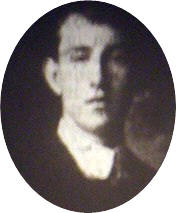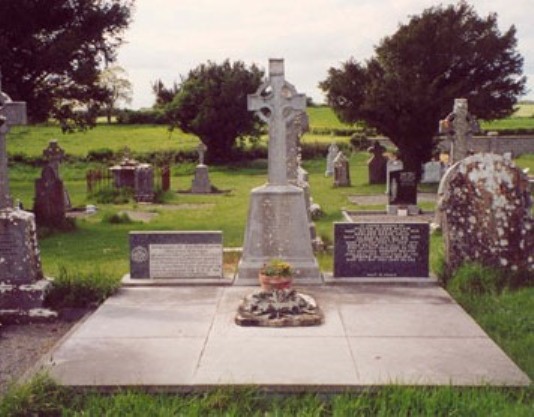Eamonn Bulfin (1892 - 1968)
Argentine-born Irish Patriot, Veteran of the 1916 Easter Rising, Irish Republic Representative to Argentina.
Born in Argentina did not diminish Eamonn's love for Ireland, the birth land of his parents and their ancestors. On his family's return to Ireland in 1902, Eamonn was immediately embedded in the cultural nationalism movement taking hold in Ireland at that time. By virtue of his enrollment in St. Enda’s, the school founded and managed by Padraic Pearse, he became a committed Irish Republican who went on to take part in the Easter Rising. He will be forever remembered as the Volunteer lieutenant who hoisted the green flag bearing the words ‘Irish Republic’ over the GPO at the onset of the Rising on Monday, April 24, 1916.
---------------------------------------------------------------------------------------------------------------------------
 Eamonn
Bulfin was born in Buenos Aires, Argentina in
1892, the first of five children born to
William Bulfin of Derrinlough, Co. Offaly,
and Ann O’Rourke of Ballymore, Co. Westmeath.
Eamonn
Bulfin was born in Buenos Aires, Argentina in
1892, the first of five children born to
William Bulfin of Derrinlough, Co. Offaly,
and Ann O’Rourke of Ballymore, Co. Westmeath.
The Bulfin's of Derrinlough were a well-known farming family that included in its lineage such notables as Eamonn's father, William Bulfin of 'Rambles in Eireinn' fame, Patrick Bulfin who was Lord Mayor of Dublin in 1871 and in later years Michael Bulfin one of Ireland's best-known artists.
Eamonn sister, Catalina, was secretary to the Irish revolutionary Austin Stack and married Amnesty International founder member and Nobel prize winner Seán MacBride.
Eamonn's father, William, who emigrated to Argentina in 1884 was a man of many talents. He was an Irish nationalist, pampas cowboy, journalist, author, an Irish language enthusiast and a sportsman who introduced hurling to Argentina. He was a friend of Arthur Griffith and helped Griffith launch Sinn Féin. He also helped finance Pádraic Pearse’s Scoil Éanna (St. Enda’s School) which opened in September, 1908. His energy, sense of history and political activism were some of the qualities he passed on to his children; none more so that Eamonn.
Eamonn spent his early years in Buenos Aires, where he received his early education. For purposes of this biography, it is assumed that he was educated by the Passionist Fathers who had established numerous missions in Buenos Aires and the surrounding pampas under the auspices of Father Vincent Grogan, who was the Provincial of the Passionist Fathers and Eamonn’s maternal granduncle.
After the Bulfin's returned to Ireland in 1902, Eamonn enrolled in St Thomas Aquinas College, a boarding school for boys, located in Newbridge Co. Kildare. In his book “Rambles in Erin” (published in 1907) Eamonn's father, William, said of Newbridge College that: “It is an educational institution that does its business on an Irish plan. It is bringing up youths in the knowledge and love of their native land.”
In 1908 after St. Enda's School, a secondary school for boys was founded by Patrick Pearse in Ranelagh, Co. Dublin, Eamonn was the second student to enroll there. In 1911 after he completed his studies at St. Enda's he enrolled in University College Dublin (UCD). While attending UCD he continued to reside in St. Enda's where he performed various tasks, including teaching. From the time he entered St. Enda's in 1908 up until and during the Easter Rising in 1916 he was a reliable resource and a trusted friend to Padraic Pearse. He was also a member of the Gaelic League and an affluent Irish speaker.
In the summer of 1812 Eamonn was introduced to the Fianna Circle of the Irish Republican Brotherhood (IRB) by Con Colbert who was a teacher at St. Enda's and one of the leaders executed by the British after the Easter Rising of 1916. Shortly afterwards he sworn into the IRB by Art O'Connor on the grave of Wolfe Tone in Bodenstown churchyard in Kildare. Together with other members of the Circle they used to practice with replica rifles and revolvers in the Foresters Hall in Parnell Square in Dublin.
The Irish Republican Brotherhood originally named The Revolutionary Brotherhood was established in 1858 by John Stephens and others, ostensibly, to free Ireland from British control by force of arms after all attempts by peaceful means had failed.
When the Irish Volunteers were formed in 1913, Eamonn and many of the older students in St Enda's, who had been sworn into the IRB, joined the Rathfarnham Company. By 1915 he was sufficiently versed in military procedures and tactics that he was assigned responsibility for organizing the Volunteers in areas of Dublin and Meath.
Eamonn who was a talented hurler was on the UCD hurling team that won the 1915 inter-college Sigerson Cup. That same year he was the captain of the UCD hurling team that won the Fitzgerald Cup a similar inter-college hurling contest. He was one of three Sigerson Cup winners who fought in the GPO during the Rising; the other two been Frank Burke and Brian Joyce.
Towards the end of 1915 Eamonn was involved in manufacturing and testing hand grenades and shotgun shells at St. Enda's for the planned Rising. He devoted most of his time to that task up to, and during, the Easter Rising in 1916.
On Easter Sunday the day before the Rising Eoin McNeill's Chief-of-Staff of the Irish Volunteers ordered the Volunteers to stand down and not take part in the Rising. Unwilling to back away from a sacred duty Lieutenant Eamonn Bulfin ignored McNeill's order and set about mobilizing his company. On Monday morning he and his company of volunteers made their way to Liberty Hall and from there to the General Post Office (GPO) on orders received from William Pearse. When Eamonn and his fellow volunteers arrived at the GPO they were ordered to take up a position on the roof by Padraic Pearse, the garrison commandant. Their first task was to raise one of the two flags that remained hoisted over the GPO for the duration of the Rising. Eamonn raised the flag of the Irish Republic on the Prince Street corner of the GPO and the other flag, the tricolor, was raised by one of the Liverpool Irish volunteers from the Kimmage Garrison.
The Rathfarnham volunteers remained in position on the roof until relieved on Wednesday evening. From Wednesday evening until Friday, they manned the barricades on the ground floor. Late on Friday evening they, together with other volunteers, were ordered by Padraic Pearse to make their way to the Williams and Wood Chocolate Factory in King's Inn. They proceeded across Henry Street under fire into Henry Place. From their they made their way along Henry Place onto Henry Street under continuous fire. By the time they approached the barricades at the junction of Henry Street and Parnell Street they received word of the surrender and were ordered to dump as many of their weapons as they could.
Eamonn, together with his fellow volunteers marched back along the route they had taken some hours earlier to the Parnell Monument in Sackville Street, (now O'Connell Street), where they laid down their remaining arms and surrendered to British forces.
When British General John Maxwell was brought to Ireland and put in charge of the British war machine, he was given a free rein to crush the Rising by any and all means possible. In the aftermath he was determined to extract revenge on those who dared challenge British rule in Ireland. He rounded-up and incarcerate over 3,000 men and women. 170 of those were field court-martialed and ninety received death sentences. Eamonn was one of the ninety who received the death sentence. Immediately after the sentences were handed down Maxwell ordered the executions to begin starting with the highest-ranking officers.
Shortly after the executions began the British realized that they were counterproductive and ordered Maxwell to stop. Undeterred he continued on until Asquith confronted him in Ireland and forced him to call a halt. After the executions were stopped Eamonn was incarcerated Stafford Jail in England and Frongoch prison camp in Wales.
Upon his release in December of 1916, he returned to his home in Co. Offaly where he rejoined the Irish Volunteers. He was appointed second in command of the Birr Battalion; a position he held until his arrest in July of 1918 on suspicion of been involved in the so-called German Plot. He was interned in Maryborough Prison (now Portlaoise Prison), before been transferred to Burnham Jail in Somerset, England. He was released in May1919 and immediately deported to Argentina.
On his arrival in Argentina, Eamonn was arrested on suspicion of being a communist, the reason given by the British for his deportation. He was subsequently conscripted into the Argentine army before being transferred to the navy. He was discharged after ten months having qualified for an exemption from military service due to his mother's death.
After his release, Eamonn was appointed by the President of Dáil Éireann, De Valera, as the first representative of the Ireland Republic to Argentina. Among the aims of his mission were 1) inaugurate direct trade between Ireland and the Argentine Republic, and 2) co-ordinate Irish opinion in the Argentine, and bring it into line with the Irish demand for a Republic. Together with Laurence Ginnell and other Irish Republicans in Argentina he launched the Irish Fund and negotiated shipments of ammunitions to the Irish Republican Army leading up to and during the Irish War of Independence.
In 1920 while residing in Argentina, Bulfin was elected to a seat on the County Council of King’s County and immediately appointed its chairman. One of the first acts of the new council was to change the name of the county from King's County to its historic name; County Offaly and recognize Dail Eireann as the legitimate government of the Irish Republic.
In July of 1922, Bulfin returned to Ireland and took up residence in the family's ancestral residence, Derrinlough House in Birr, Co. Offaly. Shortly after his return he handed over £600, outstanding from the Argentine mission to the anti-Treaty Republican forces. He refused to take part in the Treaty War aka Civil War, having decided that the Irish Republic he fought for in 1916 was eviscerated by the Treaty, the die was cast, the British had prevailed. He would not participate in their endgame.
In 1927 Bulfin married Nora Brick of Tralee, a former member of Cumann na mBan, in an Irish language ceremony. They had four children. In addition to his farming responsibilities, he worked at the Revenue Commission as a tax collector and later as the administration of old age pensions in Birr. He participated in local events and was a member of Muintir na Tíre as was his wife, Nora, Muintir na Tíre was, and still is, a voluntary organization dedicated to community development. In 1936 he was awarded a military service pension
In the early 1950s, Bulfin discovered papers belonging to Patrick Pearse amongst his father's effects given to him by Margaret Pearse to safeguard from British raids on St Enda's. Amongst the trove of historic documents was an unfinished play in Irish, Eoghan Gabha ('Owen the blacksmith'), set in the Jacobite era. He donated the material to the National Library of Ireland.
In 1966, he retired from farming and moved to Donnybrook in Dublin. He died of a cerebral hemorrhage in the Meath Hospital, Dublin, on 24 December 1968. He was buried in Eglish Cemetery in Co. Offaly.
Contributed by Tomás Ó Coısdealbha
Cemetery
Name: St. James Catholic Church graveyard
ADDRESS: Eglish, Birr, Co. Offaly, Ireland
GRAVE


